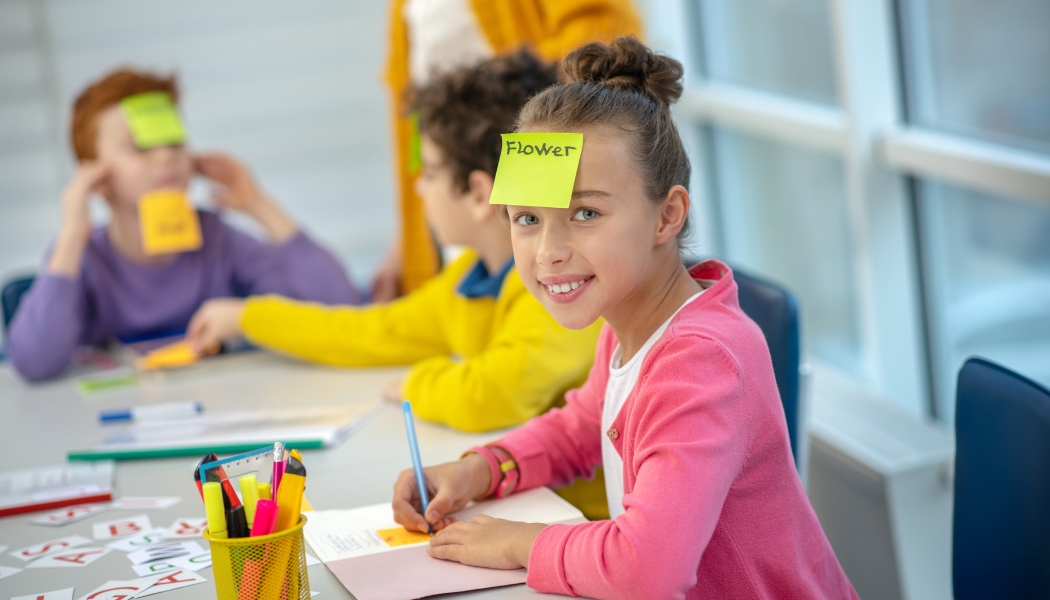Many children find writing difficult at first. Some are full of ideas but don’t know how to organize them. Others hesitate because they worry about spelling or grammar. That’s where creative writing exercises can really help.
For students in Years 2 to 8, writing regularly builds more than just language skills. It strengthens thinking, expands vocabulary, and helps children express themselves with clarity. The earlier this habit starts, the easier it becomes to write with confidence in any subject.
In this blog, you’ll find 50 creative writing activities designed to spark ideas, build structure, and make writing a skill your child enjoys practicing. These aren’t random prompts; they’re grouped with intention, so you can pick what suits your child’s level and interests best.
TL;DR:
-
Creative writing builds more than just English skills, it boosts confidence, imagination, and emotional expression.
-
The 50 activities are grouped into easy-to-follow themes: story starters, character building, plot structure, writing games, descriptive writing, real-world prompts, and reflective journaling.
-
Each activity is designed to be fun, simple, and effective for children in Grades 2 to 8.
-
These activities help children overcome writer’s block, write with purpose, and enjoy the writing process.
-
FunFox Writers Club integrates these strategies into weekly live classes, giving kids a space to write, share, and grow with expert support.
Why Creative Writing Exercises Matter?

Creative writing isn’t just about stories and poems; it helps children become better thinkers, readers, and communicators. For students in primary school, writing exercises are a hands-on way to develop key skills that support learning in every subject.
Here’s why this matters:
-
It builds confidence. When children practice writing regularly, they feel more comfortable putting their thoughts into words. This boosts their willingness to speak, share ideas, and participate in class.
-
It improves structure and clarity. Through guided exercises, kids learn how to organize ideas, build paragraphs, and stay on topic- all important for both academic and real-world writing.
-
It sharpens creative thinking. Writing stories, letters, or descriptive scenes trains children to imagine, problem-solve, and communicate emotions in different ways.
-
It supports reading growth. Writing and reading go hand in hand. A child who writes more also reads more thoughtfully, understands texts better, and learns to analyze meaning from context.
Most importantly, creative writing helps students see language as something they can shape and use, not just something to memorize or get “right.” It becomes a tool for curiosity, self-expression, and learning.
50 Inspiring Writing Exercises for Primary School Students

To make things easier to explore, we’ve grouped these writing prompts into five engaging categories. You can use them as quick daily activities or as part of a longer writing session, whatever works best for your child’s energy and interest on the day.
These prompts are designed to be flexible. You can scale them up or down based on your child’s age, reading level, or writing ability. Most importantly, they’re crafted to build both skill and confidence.
Story Starters & Imagination Builders
For many children, the biggest writing challenge isn’t spelling or grammar, it’s knowing how to begin. That blank page can feel intimidating. That’s where structured story-building activities come in. These aren’t just random prompts. They’re designed to activate creativity, lower stress, and help young writers organize their thoughts in fun, approachable ways.
Each activity below is built to support key writing skills like sequencing, sentence formation, and idea development- all while keeping things playful and low-pressure.
1. “What If?” Prompts
Give a fun and open-ended scenario like “What if pets could talk?” or “What if you woke up in a video game?” and let your child take the story forward.
What it improves: Imagination, creative risk-taking, and spontaneous storytelling.
2. Soundtrack Writing
Play instrumental music (happy, sad, dramatic) and ask your child to write a short scene that fits the mood of the music.
What it improves: Emotional storytelling and atmosphere-building.
3. Finish the Sentence
Start with something like “I opened the door and saw…” and ask your child to finish the story in a paragraph.
What it improves: Plot continuity and quick creative thinking.
4. Story Box Challenge
Fill a small box with random items (like a toy car, a leaf, a coin). Your child picks three and writes a story using all of them.
What it improves: Problem-solving and detail integration.
5. Alternate Ending
Pick a well-known story or fairy tale and ask your child to rewrite the ending in their own way.
What it improves: Creative rewriting and critical thinking.
These activities are great for after-school practice, weekend writing sessions, or even classroom warm-ups.
Character Creations & Dialogue Fun

Once children start building stories, they often get stuck on who their story is about. Characters are the heart of any narrative; they drive the plot, make choices, and help readers connect emotionally. But for kids, coming up with characters and giving them a voice can feel tricky at first.
This section focuses on fun, age-appropriate writing activities that help students create unique characters and write believable dialogue, even if they’re just starting out.
6. Character Profile Sheet
Ask your child to fill out a character profile: name, age, likes, dislikes, fears, favorite color, and secret dream.
What it improves: Character depth and consistency.
7. Create a Character from an Object
Give your child an object (e.g., a feather, old shoe, keychain) and ask them to create a character inspired by it.
What it improves: Abstract thinking and imagination.
8. Superpower & Flaw Combo
Challenge them to create a character who has a cool power (like invisibility) but also a big flaw (like fear of being alone).
What it improves: Balanced character traits and tension-building.
9. Character Mood Swap
Ask your child to write a character acting in three different moods- excited, bored, and angry, using the same setting.
What it improves: Emotional range and show-don’t-tell skills.
10. Who’s in Your Backpack?
Let them describe what’s in a character’s backpack or pockets and use those items to reveal things about their personality.
What it improves: Indirect characterization and world-building
Also read: 20 Narrative Writing Prompts for Kids & Teens
Word Play & Vocabulary Builders

Vocabulary isn't only about learning new words. It's about helping kids express themselves in better, more specific ways. These activities build a strong foundation while keeping things fun and age-appropriate for students from grades 2 to 8.
11. Word Swap Challenge
Give your child a basic sentence like “The dog is fast.” Ask them to replace “fast” with three stronger words like “speedy,” “quick,” or “lightning-fast.”
What it improves: Word variety and descriptive thinking.
12. Vocabulary Jar
Create a jar filled with fun or interesting words. Each day, pull one out and use it in a sentence or short paragraph.
What it improves: Daily word exposure and memory through use.
13. Synonym Switch Game
Pick a word like “happy” and challenge your child to come up with five different words that mean the same thing.
What it improves: Language flexibility and vocabulary range.
14. Senses Scavenger Hunt
Choose an object around the house. Ask your child to describe it using all five senses: what it looks, sounds, feels, smells, and tastes like (if safe).
What it improves: Descriptive writing and sensory language.
15. “Ban the Boring” List
Work with your child to create a list of common, overused words like “good” or “nice.” Then, build a replacement list of more exciting options.
What it improves: Editing skills and expressive vocabulary.
16. Word of the Week Story Challenge
Pick one new word each week. Your child must write a short story using that word at least three times.
What it improves: Repetition-based vocabulary recall and creative use.
17. Riddle Me This
Introduce wordplay through riddles and let your child try writing their own.
What it improves: Word association, logic, and creative language.
18. Opposites Day
Give a short story prompt and ask your child to rewrite it using antonyms wherever possible.
Example: “The boy was brave” becomes “The boy was scared.”
What it improves: Understanding word meanings and context.
19. Word Ladder Writing
Start with a simple word (like “run”) and build a ladder by finding related or stronger verbs: jog, race, dash, sprint. Then use each one in a different sentence or scene.
What it improves: Vocabulary depth and word selection skills.
20. Visual Word Builders
Show your child a picture (an animal, a street, a fantasy place) and ask them to list as many words as they can related to it, then use those words to write a description.
What it improves: Vocabulary recall and theme-based word grouping.
Plot Twists & Story Endings

Writing a good story is one thing. But keeping a reader hooked and ending strong? That’s what makes a young writer stand out. These activities help children think more creatively, develop flexible thinking, and learn how to shape satisfying story arcs.
21. Story Switch-Up
Start with a basic story idea. Midway, introduce a surprise twist, maybe the hero turns into the villain, or the pet starts talking.
What it improves: Imagination and adaptability in writing.
22. Two-Sentence Endings
After reading a story or writing one, ask your child to come up with two possible endings. One happy and one unexpected.
What it improves: Flexible thinking and ending structure.
23. “What Happens Next?” Game
Give your child a story opening and pause before the climax. Ask them to predict or write what might happen next.
What it improves: Sequencing and forward-thinking in storytelling.
24. Alternate Ending Rewrites
Take a well-known story (like a fairy tale) and ask your child to rewrite the ending completely.
What it improves: Narrative creativity and originality.
25. Flash Fiction Finishers
Give your child a writing prompt and challenge them to write a complete story in 100 words or less, with a clear beginning, middle, and end.
What it improves: Precision in storytelling and structure awareness.
26. Ending the Scene Exercise
Give your child the last line of a scene or story. Ask them to build the whole story backward, ending with that line.
What it improves: Story mapping and narrative control.
27. Genre-Twist Challenge
Take a typical fairy tale and rewrite it in another genre like horror, mystery, or sci-fi.
What it improves: Genre awareness and creative reinvention.
28. Problem–Solution Plots
Ask your child to create a story with a clear problem and resolution. Help them think through cause and effect.
What it improves: Logical sequencing and conflict resolution.
29. Character Choice Paths
Present a character with a big choice and ask your child to write two versions of the story- one for each decision.
What it improves: Perspective taking and plot exploration.
Character Building & Dialogue Writing

A good story needs characters that feel real and speak like actual people. These activities help children develop believable personalities, motivations, and conversations in their writing. It also builds empathy, which strengthens their emotional intelligence as well as their storytelling.
30. Character Sketch Cards
Ask your child to create a “character card” with details like name, age, favorite food, fear, secret, and biggest dream.
What it improves: Character depth and consistency.
31. Create a Character Backstory
Have them write a one-paragraph backstory explaining who the character is and what led them to this moment.
What it improves: Motivation building and character-driven plots.
32. Dialogue Doodle
Give two characters a situation (e.g., lost in a mall) and have your child write only their conversation, without any narration.
What it improves: Voice, pacing, and natural dialogue flow.
33. Emotion Switch-Up
Choose one emotion, like “nervous,” and have your child write how a character acts, speaks, and thinks when feeling that.
What it improves: Show-don’t-tell and emotional expression.
34. “What Would They Say?” Game
Present a scenario (e.g., someone spills juice) and ask what three different characters might say.
What it improves: Understanding of personality through voice.
35. Character Quirks List
Ask your child to give each character a unique habit or quirk (like humming when nervous or always wearing mismatched socks).
What it improves: Memorable character traits and realism.
36. Build a Character Through Objects
Please have your child describe a character using only the things in their backpack, bedroom, or desk.
What it improves: Indirect character building and imagination.
37. Character Conflict Roleplay
Write a scene where two characters disagree about anything, and your child writes both sides of the argument.
What it improves: Balanced dialogue and character contrast.
Creative Prompts & Genre Challenges

Giving children a specific genre or unusual writing prompt can stretch their imagination and encourage them to experiment with different styles. These activities help build confidence and adaptability in storytelling across formats.
38. Genre Spinner Challenge
Write a simple story prompt and spin a paper wheel with genres like mystery, fantasy, sci-fi, or comedy. Whatever it lands on is the genre they must use to complete the story.
What it improves: Genre flexibility and creativity.
39. Picture Prompt Writing
Show your child a random photo. It could be a beach, an old house, or a dog with a balloon. Ask them to write a story inspired by what they see.
What it improves: Visual storytelling and scene setting.
40. News Headline Prompt
Pick a silly or real news headline (e.g., “Penguin Escapes Zoo and Goes Shopping”) and ask your child to write the full story behind it.
What it improves: Creative expansion and narrative building.
41. Genre Mashup
Challenge your child to combine two genres in one story. For example, a romantic comedy set in outer space or a mystery with magical creatures.
What it improves: Inventiveness and cross-genre exploration.
42. One-Word Story Starter
Give a single word like “shadow,” “portal,” or “whistle,” and have your child write a full story around it.
What it improves: Thematic consistency and imaginative thinking.
43. Rewrite a Classic
Ask your child to take a classic fairy tale or fable and rewrite it in a modern setting or with a twist.
What it improves: Adaptation skills and storytelling variation.
44. Unlikely Hero Challenge
Have your child create a main character who is completely unexpected, like a shy fish, a broken robot, or a forgetful dragon.
What it improves: Character originality and plot flexibility.
Reflective Writing & Personal Expression

These activities guide children to look inward, helping them express their thoughts, feelings, and experiences through writing. It nurtures self-awareness, emotional development, and confidence in using their own voice.
45. “My Favorite Moment” Journal
Ask your child to write about a moment from the past week they really enjoyed, even something simple like eating ice cream or playing with a friend.
What it improves: Observation and emotional recall.
46. Letter to Future Me
Have them write a letter to themselves in the future, maybe 1 or 5 years from now, about what they hope to achieve or remember.
What it improves: Goal-setting and introspection.
47. Gratitude Lists with Stories
Ask them to list three things they’re thankful for, and then write a short paragraph about one of them in detail.
What it improves: Positive thinking and reflective writing.
48. “If I Were…” Prompts
Give prompts like “If I were a teacher for a day…” or “If I could time travel…” and let them explore their imagination and values.
What it improves: Perspective-taking and creative reflection.
49. Personal Metaphors
Challenge your child to write a short paragraph comparing themselves to something else (e.g., “I’m like a tree because…”).
What it improves: Self-expression and figurative language.
50. Today’s Story Snapshot
At the end of the day, ask them to write a 3-4 sentence “story snapshot” of what happened, focusing on how they felt, what surprised them, or what they learned.
What it improves: Daily reflection and habit-building in writing.
How FunFox Writers Club Supports These Creative Writing Activities

Every activity you’ve seen above is already woven into how we teach at FunFox. The Writers Club isn’t just about following worksheets; it’s about building a real love for writing in a way that fits each child’s unique learning style.
Here’s how FunFox brings these writing experiences to life:
-
Small group learning: With just 3–6 students per class, our teachers tailor writing prompts and discussions to suit each child’s strengths and challenges. That means shy writers build confidence, and budding authors get the stretch they need.
-
Fun-first approach: From mystery prompts to genre challenges, every session includes games, story-building tasks, or character design, all built around the Australian curriculum.
-
Real-time feedback: Kids get support while they’re writing, not just after. Teachers gently guide sentence structure, grammar, vocabulary, and creativity during the activity itself.
-
Replayable sessions: Can’t remember how the story ended? Our class recordings help students go back, reflect, and refine their ideas at their own pace.
-
Evidence-based methods: Everything we teach is backed by proven literacy strategies that improve creative writing outcomes in primary years, while still keeping it fun.
In short, the FunFox Writers Club is the perfect place for children to build and enjoy writing habits that last.
Wrapping Up
Creative writing isn’t something kids should be forced into. When it’s done right, it becomes a space where they feel free, confident, and proud of what they create. That’s exactly what the FunFox Writers Club is designed to do.
Enroll now or Book a free trail class to get started with a free trial class and see your child’s creativity grow from the very first session.
FAQs
1. What if my child runs out of ideas halfway through a story?
That’s very common, even adult writers experience it. The best way to handle it is by encouraging your child to “write through it.” Use tools like question prompts (What happens next? What if the character did the opposite?) or story dice to push past the block without pressure.
2. Is it better to let my child type their stories or handwrite them?
Both have benefits. Handwriting builds motor skills and memory retention, while typing can be faster and less frustrating for kids who struggle with writing speed. You can switch based on your child’s comfort and the goal of the activity.
3. How can I help my child improve without correcting everything they write?
Focus on one thing at a time. For example, during one activity, just look at punctuation. In another, help them build stronger characters. Avoid red-pen overload; it discourages creativity. Instead, praise what’s working and gently guide improvements.
4. My child only writes when it’s assigned at school. How do I change that?
Make writing feel less like homework. Use creative prompts based on their favorite games, books, or shows. Give them space to write in a fun notebook or on a shared Google Doc with you, make it feel like a game or a journal, not an assignment.
5. At what age should I expect my child to start writing full stories?
There’s no fixed age. Some kids start building full narratives in Grade 2, others take more time. What matters is nurturing their ideas and helping them feel that their thoughts are worth sharing. Short paragraphs or comic strips count too!














